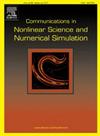Nonlinear dynamics analysis of labyrinth seal-rotor system considering internal friction in coupling
IF 3.4
2区 数学
Q1 MATHEMATICS, APPLIED
Communications in Nonlinear Science and Numerical Simulation
Pub Date : 2025-01-21
DOI:10.1016/j.cnsns.2025.108640
引用次数: 0
Abstract
The performance and efficiency of the mechanical system usually depend on the coordination between the rotor and other mechanical components. Due to the sliding motion between the coupling teeth, investigating the instability of the rotor is essential. The action of the coupling can cause changes in the seal performance. The article establishes a nonlinear dynamic rotor model that considers the coupling of internal friction and labyrinth seal, which is a dimensionless treatment and seeks to use the numerical method. The study investigated the impact of various parameters such as axial pressure drops, seal clearance, and seal length. Exploring the change of rotor system stability under the coupling effect of internal friction and labyrinth seal. By combining time history, bifurcation, and axis center trajectory analyze the dynamic characteristics, motion state, and seal force. The results indicate that the rotor system's stability decreases as speed increases with increased vibration amplitude. The increase in axial pressure drop causes the rotor system motion bifurcation point to advance, but it can suppress the offset at the first-critical speed. The increase in seal length can improve the seal effect, but the unstable speed becomes advanced, and the system stability is reduced. This study considers multiple factors and provides theoretical support for the dynamic design of the rotor system.
求助全文
约1分钟内获得全文
求助全文
来源期刊

Communications in Nonlinear Science and Numerical Simulation
MATHEMATICS, APPLIED-MATHEMATICS, INTERDISCIPLINARY APPLICATIONS
CiteScore
6.80
自引率
7.70%
发文量
378
审稿时长
78 days
期刊介绍:
The journal publishes original research findings on experimental observation, mathematical modeling, theoretical analysis and numerical simulation, for more accurate description, better prediction or novel application, of nonlinear phenomena in science and engineering. It offers a venue for researchers to make rapid exchange of ideas and techniques in nonlinear science and complexity.
The submission of manuscripts with cross-disciplinary approaches in nonlinear science and complexity is particularly encouraged.
Topics of interest:
Nonlinear differential or delay equations, Lie group analysis and asymptotic methods, Discontinuous systems, Fractals, Fractional calculus and dynamics, Nonlinear effects in quantum mechanics, Nonlinear stochastic processes, Experimental nonlinear science, Time-series and signal analysis, Computational methods and simulations in nonlinear science and engineering, Control of dynamical systems, Synchronization, Lyapunov analysis, High-dimensional chaos and turbulence, Chaos in Hamiltonian systems, Integrable systems and solitons, Collective behavior in many-body systems, Biological physics and networks, Nonlinear mechanical systems, Complex systems and complexity.
No length limitation for contributions is set, but only concisely written manuscripts are published. Brief papers are published on the basis of Rapid Communications. Discussions of previously published papers are welcome.
 求助内容:
求助内容: 应助结果提醒方式:
应助结果提醒方式:


